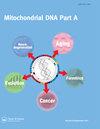COI和COII基因变异对库蚊系统发育重建和隐种鉴定的适用性评价
IF 0.6
4区 生物学
Q4 GENETICS & HEREDITY
引用次数: 19
摘要
摘要本研究评估了利用线粒体COI和COII基因变异进行蚊种鉴别和重建按蚊系统发育的可行性和有效性。根据线粒体COI基因(92种)和COII基因(108种)的部分序列推断按蚊亚科之间的系统发育关系。在简约、极大似然和贝叶斯方法的基础上重构了系统发育树。通过比较COI和COII基因变异在种群和复合体内的序列差异,比较了COI和COII基因变异对隐种鉴定的适用性。结果表明,COI基因对鉴定兄弟种和隐种更有用,但用COII基因重建的系统发育关系与基于形态数据的系统发育关系更相似。我们得出结论:(1)安属植物存在显著的分子分化。制成;(2) COI和COII是解决按蚊之间分类关系的有效遗传标记,由此产生的系统发育对按蚊种群和复合体的分类地位提出了一些疑问;(3)按蚊属与比罗纳氏菌属没有明显的单系性;(4) Kerteszia亚属和Nyssorhynchus亚属是单系的;(5)在类群水平下,COI数据支持在funestus按蚊、maculipennis按蚊、strode按蚊和barbirostris按蚊亚群以及nuneztovari按蚊复合体中存在单系分类群,而COII数据支持在minimuites按蚊、oswaldoi按蚊亚群和hycanus按蚊群中存在单系分类群。冈比亚按蚊和albitarsis按蚊复合体中的单系分类群得到了COI和COII数据的支持。本文章由计算机程序翻译,如有差异,请以英文原文为准。
An evaluation of the suitability of COI and COII gene variation for reconstructing the phylogeny of, and identifying cryptic species in, anopheline mosquitoes (Diptera Culicidae)
Abstract We assessed the practicality and effectiveness of using variation in the mitochondrial COI and COII genes to discriminate species and reconstruct the phylogeny of anophelene mosquitoes. Phylogenetic relationships among the subfamily Anophelinae were inferred from portions of the mitochondrial COI (92 species) and COII genes (108 species). Phylogenetic trees were reconstructed on the basis of parsimony, maximum likelihood and Bayesian methods. The suitability of COI and COII gene variation for identifying cryptic species was compared by comparing the sequence divergence within species groups and complexes. The results show that the COI gene was more useful for identifying sibling and cryptic species, but that phylogenetic relationships reconstructed using the COII gene were more similar to those based on morphological data. We conclude that: (1) there is a significant molecular divergence among An. sinensis; (2) the COI and COII are valid genetic markers for resolving taxonomic relationships among anopheline mosquitoes and the resultant phylogeny raises some questions about the taxonomic status of anopheline species groups and complexes; (3) the genus Anopheles is not demonstrably monophyletic with regard to the genus Bironella; (4) the subgenera Kerteszia and Nyssorhynchus are monophyletic; (5) below the group-level, COI data support the existence of monophyletic taxa within the Anopheles funestus, Anopheles maculipennis and Anopheles strode and Anopheles barbirostris subgroups, and within the Anopheles nuneztovari complex, whereas COII data support the monophyletic taxa within the Anopheles minimus and Anopheles oswaldoi subgroups, and Anopheles hyrcanus group. The monophyletic taxa within the Anopheles gambiae and Anopheles albitarsis complexes are supported by both COI and COII data.
求助全文
通过发布文献求助,成功后即可免费获取论文全文。
去求助
来源期刊

Mitochondrial Dna Part a
Biochemistry, Genetics and Molecular Biology-Genetics
CiteScore
3.00
自引率
0.00%
发文量
6
期刊介绍:
Mitochondrial DNA Part A publishes original high-quality manuscripts on physical, chemical, and biochemical aspects of mtDNA and proteins involved in mtDNA metabolism, and/or interactions. Manuscripts on cytosolic and extracellular mtDNA, and on dysfunction caused by alterations in mtDNA integrity as well as methodological papers detailing novel approaches for mtDNA manipulation in vitro and in vivo are welcome. Descriptive papers on DNA sequences from mitochondrial genomes, and also analytical papers in the areas of population genetics, phylogenetics and human evolution that use mitochondrial DNA as a source of evidence for studies will be considered for publication. The Journal also considers manuscripts that examine population genetic and systematic theory that specifically address the use of mitochondrial DNA sequences, as well as papers that discuss the utility of mitochondrial DNA information in medical studies and in human evolutionary biology.
 求助内容:
求助内容: 应助结果提醒方式:
应助结果提醒方式:


